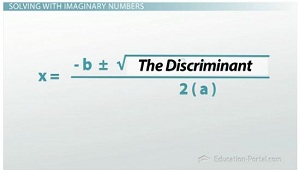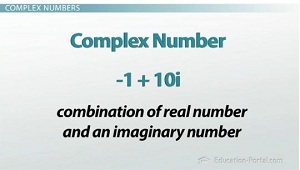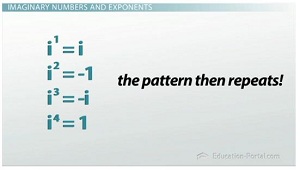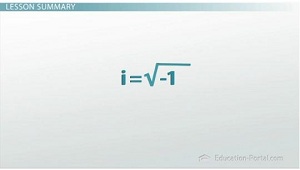What is an Imaginary Number?
After you watch the video and know the material, click HERE for the quiz.
The imaginary number 'i' is the square root of -1. Although this number doesn't actually exist, pretending that it does allows us to do a bunch of crazy math that scientists use every day. Learn the basics of that number 'i' here!
Introduction
If you've seen many of these videos, you might know that I live in California, but I actually just recently moved back home to the Midwest to be close to family. Before I left, though, there were a few things I wanted to do as a farewell to California. Along with going to the beach and riding my motorcycle through the Santa Cruz Mountains, a bicycle ride through San Francisco seemed like a good way to see the city one last time.
One of the sights I had to see was the Golden Gate Bridge, and I decided that biking across it would be a good idea. Actually, it was a terrible idea! It was crazy windy! It honestly knocked me over one time - like, I fell off my bike. It got me thinking: how the heck has this bridge stood here for 75 years defying this wind 24/7? Well, it turns out the answer is that engineers did their math!
Where Imaginary Numbers Come From
I don't know the exact equations they used, but somewhere in there, they probably needed to solve a quadratic something like this one: x^2 - 4x + 8 = 0. There's a good chance that they used the quadratic formula by substituting in the a, b and c values, and then evaluating from there. But look what happens on the inside of the square root. When you evaluate b^2 - 4ac, you end up with -16. This is a problem.
The square root of -16 doesn't exist because there is no number that, when multiplied by itself, will turn into -16. 4 * 4 is just positive 16, and -4 * -4 is also positive 16. So, what can we do? Well, we might want to take the easy way out and just say that there's no solution, but that would mean that the Golden Gate Bridge either doesn't get built or it gets built without being strong enough to withstand that crazy wind, and it collapses while I'm trying to bike across it. Neither of these options were acceptable to the builders in the 1930s. Luckily, mathematicians had already come up with a way to work around this issue: imaginary numbers.
 |
If we say, 'okay, so negative square roots don't actually exist, but let's imagine they do,' we are actually able to solve problems that allow those engineers to figure out exactly how strong to build our bridge. I know it's weird to think that imaginary numbers allow us to solve real-world problems, but it's the truth!
Solving with Imaginary Numbers
So, instead of saying our quadratic is unsolvable, we take out the negative from the square root. This turns the square root of -16 into the square root of -1 times the square root of positive 16. Now the square root of 16 is normal; it's good to go - it's got a positive number, and the square root of -1 is the only part that we have an issue with. So, what we do is we call that square root of -1 the letter i. Now we kind of just continue on like we normally would. We take the square root of 16 and get 4, then we divide both terms by 2, and we end up with our answer: x = 2 +/- 2i.
So, by isolating the part of the problem that was making it hard, which was the negative on the inside of the square root, then just giving it a letter as a name, and then saying 'let's just pretend like that's not there and do the rest of the problem like normal,' we can actually get an answer to a question that used to be unsolvable, and it helps us build bridges and all sorts of other stuff.
 |
Whether or not you'll get an imaginary number in your answer when you're solving a quadratic, all comes down to what's on the inside of the square root, which is called the discriminant. If the discriminant is positive, you'll get one of those 'normal' situations where you have two real number answers. If the discriminant is equal to 0, you'll only get one real number answer. But if the discriminant is negative, that's when you get two answers that are imaginary numbers. Now that you've seen where imaginary numbers come from, let's go over the vocabulary that's associated with them.
Complex Numbers
 |
We've already talked about the most basic imaginary unit, which is i, the square root of -1. Any imaginary number will have an i in it: 3i, 14i, -6i, -4/5i - these are all imaginary numbers. The next step is to add a real number to it, like we saw in our example just a minute ago. When you do this and get something like 2 + 2i or 5 - 3i or -1 + 10i, this is what's called a complex number. It's a combination of a real number and an imaginary one.
Imaginary Numbers and Exponents
We saw earlier that imaginary and complex numbers themselves can help us solve real-world problems, but there's another reason that they are useful. If you let yourself accept that an imaginary number might work, then there's actually a chance that it will turn back into a real number!
So, what am I talking about? Well, anything to the first power is just itself, so i^1 is i. But how about i^2? Well, i is the square root of -1, so i^2 is just the square root of -1 squared. But square roots and the power of 2 are inverse operations; they undo each other, they cancel each other out. So, all we're left with is the -1, so i^2 is just -1, a real number.
We've stumbled upon a pattern that will continue here. Given that i^2 is -1, then what might i^3 be? Well, i^3 is just i^2 * i; i^2 is just -1, and so -1 * i is just -i. So i^3 is actually just -i.
 |
Moving on to i^4 - well, that's just i^2 times i^2; i^2 is -1, so that's just -1 * -1, which is just positive 1. Again, we get a real number.
So, what we have here is this pattern. i^1 is just plain old i, but i^2 is -1 (a real number), then i^3 turns into -i, then i^4 turns back into real number positive 1. If we continue taking powers of i , we actually just end up seeing this pattern repeat over and over and over again. I know this can get a little crazy, so instead of trying to explain out each one to you, you can either try it on your own or take my word for it that i^5 would end up turning back into i, i^6 would be -1, i^7 is -i, i^8 is 1, and it kind of starts all over again. So, the pattern goes i into -1 into -i into positive 1 and then repeats.
The reason we point out this pattern is that when we're dealing with imaginary numbers we often end up with powers of them, but it's nice to be able to kind of simplify them back down to the basics. So knowing that, for example, i^7 is just -i, allows us to rewrite our number a little bit simpler.
Hopefully, you're beginning to see that if you can let yourself imagine that these other numbers might exist, a lot of other interesting patterns (which is what math is all about) begin to emerge. It's a good thing they did, or else the Golden Gate Bridge might have collapsed beneath me as I was regretting my decision for an up-close and personal look at it!
Lesson Summary
 |
To review: if you end up with the square root of a negative number, you imagine it exists by putting an i next to it, making the inside of the square root positive and then evaluating it like you normally would. That i is the square root of -1, and it's the most basic unit of an imaginary number. Going from i itself to i^2 to i^3 and on to i^4 shows us the pattern that all following powers of i will follow.
When you combine an imaginary number with a real one, you get a complex number, and when solving a quadratic equation, you can tell what kind of solutions you will get by determining whether the discriminant is positive, zero or negative.